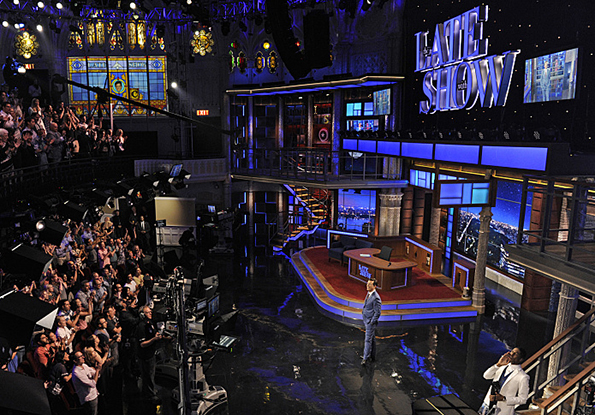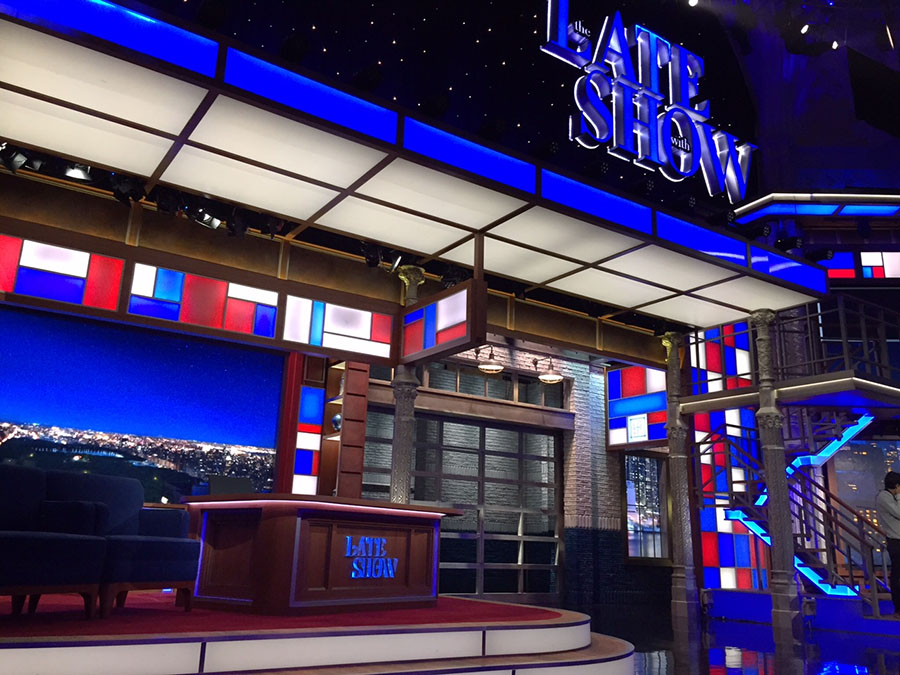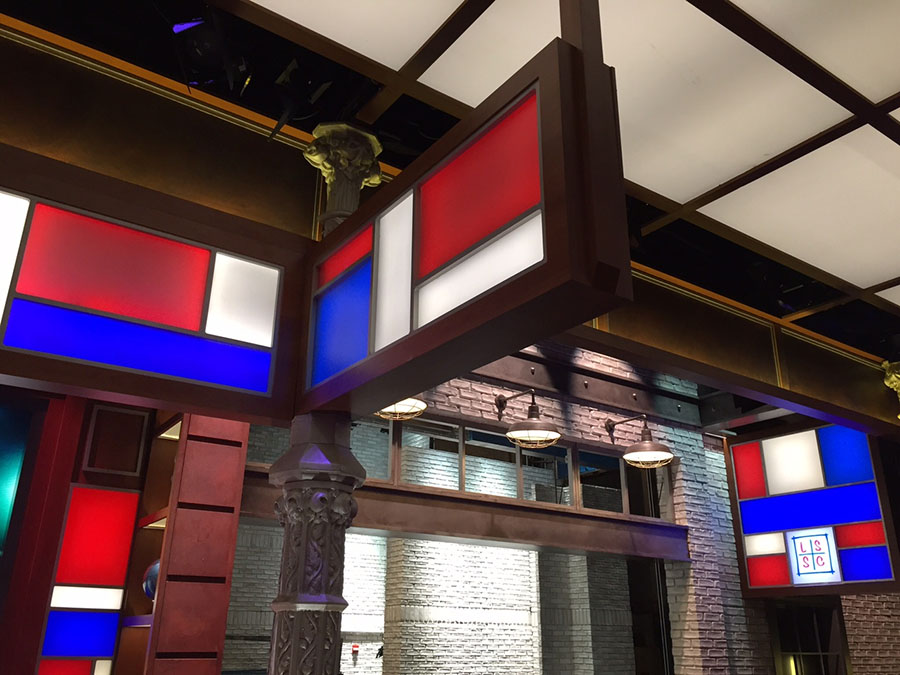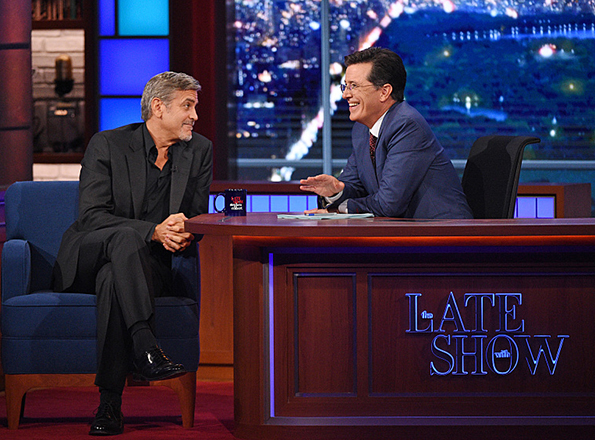Q&A: Behind the design of ‘The Late Show with Stephen Colbert’

Subscribe to NewscastStudio for the latest news, project case studies and product announcements in broadcast technology, creative design and engineering delivered to your inbox.
Stephen Colbert took over the reins of CBS’s “The Late Show” last week, marking the beginning of a new era for the network. As part of the change, significant alterations were made to the show’s home, the Ed Sullivan Theatre.
We recently had a chance to talk with Larry Hartman, senior designer on the project at Jack Morton PDG, about the changes.
Talk a little about the background of the project
Arriving at the scenic design was truly a collaborative process, that took months and many, many conversations with Stephen and his producers.
We really wanted to embrace the theatre architecture, so that the entire room could be a part of the on-screen environment.
What challenges did you face in this set design?
One particular challenge was taking this magnificent, open volume and creating an environment that directs the focus on Stephen and his guests. We did this by creating structures that connected to the soaring theatre facade, but appear to naturally divide it and organize its impact into smaller areas. The downstage ends of the stage have naves with tall columns culminating in Gothic arches.
We added balconies on each side, essentially cutting the height down to person-sized levels. This not only helped to make the scale friendlier, but also doubled the playing space for a show that will continue to grow and experiment.
To manage the towering height of the proscenium, we created a canopy that runs horizontally across at about mid-height. The space above the canopy features an LED star drop that softly twinkles behind a large, dimensional show logo. The canopy nicely frames Stephen’s interview area and the performance space below.
Talk about the design process for a project of this scale?
The design process was even more intriguing since not only was the set being designed, but the very show itself was being figured out. Stephen noted that we were being asked to “create the arena” before the game is worked out. So flexibility and giving the show a playground that could evolve were important factors in the development of the design.
To this end, another powerful feature of the new set are the large LED screens incorporated in the scenery. These include Stephen’s backdrop, as well as a flying screen in the performance area, and vertical towers flanking the proscenium.
How would you describe the design style?
Overall, the set had to be warm and inviting, with an obvious late night vibe. We wanted to reinforce the grace and textured depth of the theatre architecture, but then compliment it with modern elements, like the wood and light boxes we introduced, and then juxtapose the grittiness of the backstage with painted brick.
There is certainly a nod to the feel of the Colbert Report, with color-changing light boxes and wood shelves featuring books and Captain America’s shield.
Overall, it’s the theatre’s neo-Gothic style meeting a warm industrial chic.
The theatre’s period look features vaulted ceilings and stained glass windows. During the design process, Stephen mentioned wanting to find our own version of the stained glass, and we landed upon an almost Mondrian motif.
The rectangular colored patterns that accent the set are actually each separately controllable color-changing light boxes. Coupled with the LED displays and the rest of the traditional lighting rig, these “Mondrian light boxes” can re-skin the look of the set instantly. This will all be on display especially with the guest band performances.
What makes this set different from David Letterman’s?
There really wasn’t a substantial amount of thinking about how similar or different to be from the look of Dave’s set. We looked at all late night shows, present and past, to be informed about what is out there. But the driving force was always what will make the set right for Stephen’s show. One exception came from Dave himself.
Stephen spent some time talking with him and asked him about the theatre and his set. Stephen asked Dave what, if anything, he would have done differently. Dave replied that he would have probably flipped the sides where his desk and Paul’s band played. So Stephen took that to heart and laid out the set that way.
Beyond that flip in layout, the most obvious differences are that Stephen’s desk has been pulled downstage and angled toward the center of the audience.
The goal was to bring Stephen as close as possible to the people in the seats. He loves performing and wants to be as engaged with the audience as he can be.
The theatre was renovated by an amazing architectural and construction crew, supervised by the show’s producers. The theatre is now much more open and a part of the show look.
Design Credits
Scenic Design:
The Late Show with Stephen Colbert:
Stephen Colbert
Executive Producers – Meredith Bennett , Tom Purcell
Co-Executive Producer – Barry Julien
Jack Morton/PDG:
Production Designer – Jim Fenhagen
Senior Designer – Larry Hartman
Senior Project Manager – Matt Glaze
Senior Illustrator – Chris Maroney
Illustrators – Molly Hellring, Adaer Melgar, Jennilee Aromando
Graphic Art Director – Shelline Vandermey
Graphic Designers – Raeford Dwyer, Tamir Karta, Paul Budd
Drafters – Evan Hill, Catherine Carriere, Molly Hellring
Producer – Amanda Dwyer
Coordinator – Meredith Murphy
Scenic Build:
Black Walnut:
Managing Partners – Jac Gendelman, Mike Van Dusen
Project Managers – Frank Bradley, Lee Martindell
Installers – Konrad Majchrzak, Wyatt Peterson
Electricians – Tim Martindell, Rich Lopez
Audio Design:
Sound Designer: Broadcast Mixer and Musical Staging Supervisor – Todd Kilponen
Monitor Mixer – Jay Morgan
FOH Mixer – Bob Walker
Firehouse Productions – Mark Dittmar
Lighting Design:
Lighting Designer – Michael Scricca
Associate Lighting Director – James Milkey
Head Intelligent Lighting Programmer – Justin Cheatham
Lighting Console Operator – Constantine Leonardos
Head Electrician – Shawn Walters
Custom truss and gear by Light Action
Equipment:
- ETC source 4 LED
- GLP ×4s
Video:
D3 LED:
Jason Barak – Managing Partner Sales & Marketing
Meric Adriansen – Director of Systems Engineering
Jim Pappas – Senior Project Manager
Raphael Delacruz – Lead Technical Project Manager
Equipment:
- TE-SMD-2.5mm
- (3) 4.7’ x 6.3’ Units for Column Displays
- (1) 14’ x 11’ Unit for OTS Shots
- (1) 20.5’ x 14’ Flying Display
- TE-SMD-1.6mm
- (1) 4.7’ x 6.3’ Lower Column Display
- 565 Square Feet of UHD LED
- 9 Million Total Pixels
Traveling Images:
Steven M. Artsis – President
Orad:
Colin Sye – Project Manager
Chris Caporlingua – Broadcast Engineer
Jan Umansky – Engineer
Projection:
Bravo Media:
Tim Donovan
Ryan Kelley
On Ayinde
Automation:
Showmotion
Theatre Renovation Credits
The Late Show with Stephen Colbert:
Stephen Colbert
Executive Producer – Meredith Bennett
Supervising Producer/EIC – Tanya Bracco
CBS:
Richard Hart, VP Production & Technical Operations
Rich Solomon, Director Business Development
Architect:
Design Republic:
Project Principal – Neil Tucker
Project Architect – Ojay Obinani
Project Designer – Urszula Sidz
Project Team – Michael Fiorelli, Toufic Saad, Sefako Ketosugbo
Construction:
JRM Construction Management, LLC:
Charlie Ciccarelli
Tommy Miriello
Mechanical, Electrical, Plumbing and Fire Protection:
MGE Engineering
Structural Engineer:
Severud
Acoustic Consultant:
Shen Milsom & Wilkes
CBS Scenic Shop:
David Tasso
Tommy Bianco
Production Credits
The Late Show with Stephen Colbert:
Stephen Colbert
Executive Producers – Tom Purcell, Meredith Bennett
Co-Executive Producers – Barry Julien, Emily Lazar
Director – Jim Hoskinson
Supervising Producer/EIC – Tanya Bracco
Line Producer – Bjoern Stejskal
Video Content – Jon Pretnar (in conjunction with the show’s producers and graphics team)
Show Scenic Design Department – Andrea Purcigliotti, Brendan Hurley
Scenic Artists – Lyvan Munlyn, Bill Depaolo
Stage Crew:
Head Carpenter – Harold Larkin
Carpenters – Tom Gordon, Bill Palumbo, John Tutalo, Jose Rosario
Head Electrician – Shawn Walters
Lamp Operator – Cory Schaub
Head Intelligent Lighting Programmer – Justin Cheatham
Lighting Console Operator – Constantine Leonardos
Electricians – Martin Vanbeveren, Jimmy Palazzo, Kenny Goski
Tech manager – Tim Kennedy
Head Prop – Pat Farmer
Props – Eddie McGarry, Robert Colgane, Eugene Szymanski, Ed Costello
Subscribe to NewscastStudio for the latest news, project case studies and product announcements in broadcast technology, creative design and engineering delivered to your inbox.






tags
entertainment, Jack Morton Worldwide, larry hartman, Set Design, stephen colbert, The Late Show, The Late Show with Stephen Colbert
categories
Entertainment, Exclusives, Featured, Set Design, Studio Technology, TV Set Design